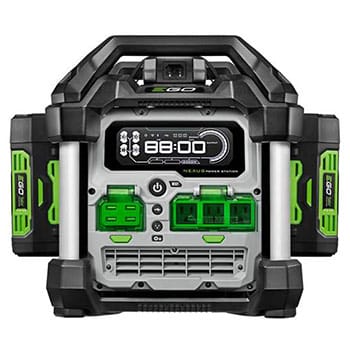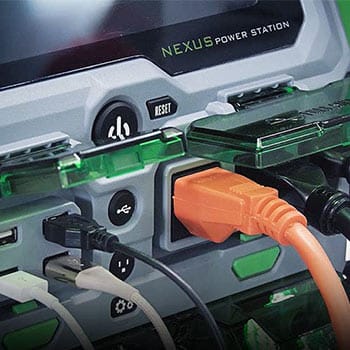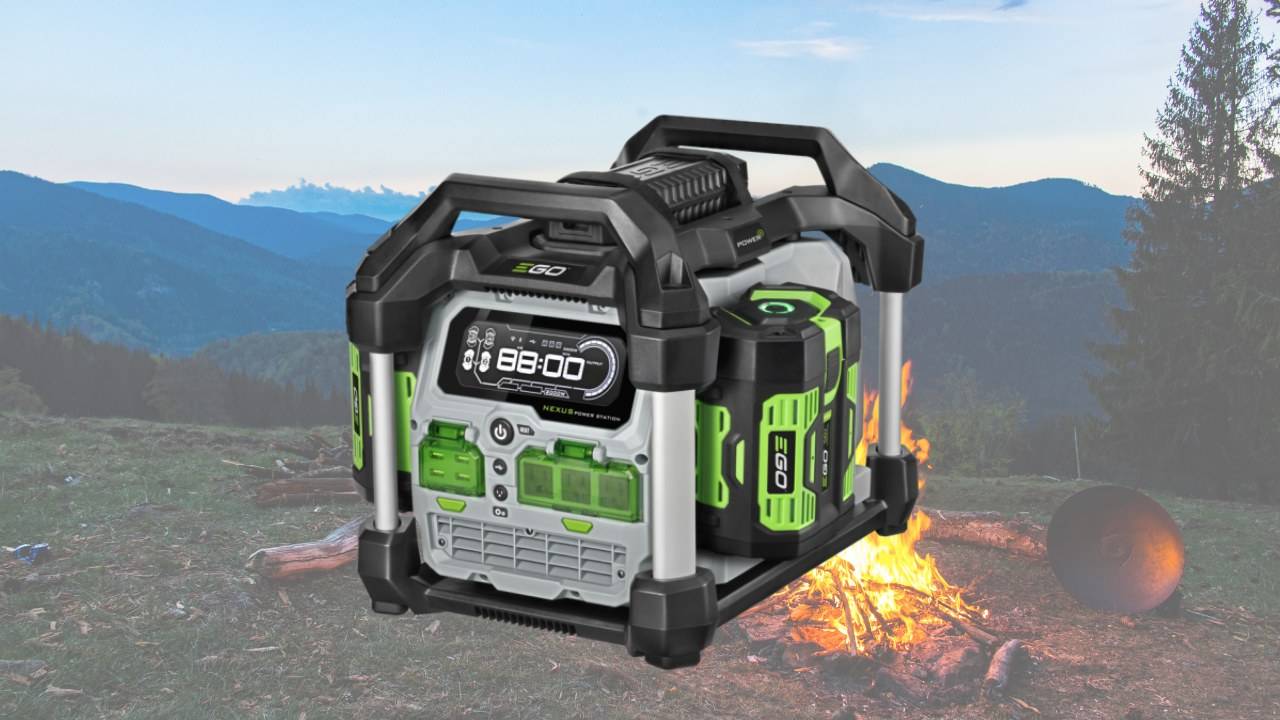Solar generators are booming — and for good reason. Whether you’re dealing with power outages, off-grid adventures, or rising electricity costs, a portable power station can offer clean, silent energy whenever and wherever you need it.
That’s probably how you landed on the EGO Power Station — especially if you already trust the brand’s cordless lawn tools. Known for leaf blowers, mowers, and chainsaws, EGO has built a strong name in outdoor battery equipment. But does that success carry over to their power stations?
That’s the big question.
In this guide, we’ll take a close look at the EGO Power Station lineup — what it gets right, where it falls short, and how it compares to top solar generator brands like Bluetti, Jackery, and EcoFlow.
If you’re thinking about buying an EGO system, this is what you need to know first.
EGO’s Sustainability Story: Lawn Tools to Portable Power
The EGO Power Station didn’t come out of nowhere. It’s part of a much larger ecosystem built by EGO Power+, a Chervon-owned brand reshaping outdoor gear with battery-powered tools. Their mission? Ditch gas, electrify everything, and do it all with a single battery.
That battery is the 56V ARC Lithium™ pack — the heart of an expanding lineup that includes everything from cordless mowers and chainsaws to leaf blowers, string trimmers, and even ride-on lawn tractors. With this modular platform, users can swap one battery between dozens of tools — a convenience that appeals to both homeowners and pros looking to cut emissions and simplify their toolkits.
That same battery now powers EGO’s three portable power stations — the Nexus Power Station, Escape 400, and Escape 150 — designed to give existing EGO users a plug-and-play backup option. If you’re already deep in the EGO ecosystem, the appeal is obvious.
But for most shoppers, especially those looking for true solar generators, adoption is modest. Online forums tend to favor EcoFlow or Bluetti for their faster solar input, higher capacity, and better value.
EGO promotes its gear under the banner of “Power Beyond Belief,” positioning battery tech as a clean alternative to gas engines.
Their Challenge 2025 campaign takes that message further: pledging a tree planted for every tool sold and highlighting ISO 14001-certified facilities, a 7,000 m² green roof, and a 2-megawatt solar array that actively offsets coal-based electricity each year.
Their parent company, Chervon (not to be confused with Chevron, the oil and gas company), echoes this mission in its annual ESG reports, promising “Better Tools, Better World” while embedding environmental benchmarks across design, manufacturing, and global supply chains.
Still, EGO’s sustainability story isn’t without gaps. U.S. customers continue to call for a proper battery take-back program, and the company has yet to publish a standalone sustainability report that details lifecycle emissions — something more common among category leaders in clean energy.
Bottom line: EGO is helping transform yard work with zero-emission tools and is making real investments in greener manufacturing — but when it comes to portable solar power and environmental transparency, it’s still catching up.
EGO Power Station Specs & Real-World Performance
At first glance, the EGO Power Station (Model PST3042) looks like a solid contender. With a rugged, roll-cage design and built-in handle, it feels more like a jobsite tool than a sleek off-grid generator. But what do the specs actually mean when it’s time to plug in?

Here’s what you’re working with:
- Battery Capacity: Configurable via EGO 56V batteries (up to 4 slots); a common setup uses 2x 7.5Ah batteries for around 840Wh total capacity.
- Output: 2000W continuous / 3000W surge — strong enough to run fridges, TVs, fans, or even a microwave in short bursts.
- Ports: 3 standard 120V AC outlets, 4 USB ports (including 2 USB-C), 1 battery-level LED display.
- Recharge Method: Wall charging only out of the box — solar charging requires third-party inverters or adapters, and performance is far from optimized.
While the power output sounds competitive, the system’s actual battery capacity depends entirely on which EGO tool batteries you use. Unlike plug-and-play solar generators that come with an internal battery and solar input, the Nexus relies on detachable batteries, which are sold separately. That’s an extra cost — and potentially, extra hassle.
It also lacks an integrated MPPT charge controller — meaning solar performance is slower, less efficient, and harder to configure compared to systems from Bluetti or EcoFlow.
Still, in use, the Nexus is dead-silent, produces zero fumes, and works great for short-term backup power or light-duty tools. It’s particularly appealing to users already invested in the EGO tool family, where battery swapping makes sense.
But for anyone outside that ecosystem? The Nexus starts to look like a limited-value proposition, especially at its price point — often comparable to fully integrated solar generators with built-in storage, solar optimization, and smart features.
Pros
Cons
- Solid 2000W output
- Modular battery system
- Quiet, fume-free operation
- Good for EGO owners
- Rugged build quality
- No built-in battery
- Solar charging not supported
- No MPPT controller
- Limited energy capacity
- Pricey for features
- Batteries sold separately
- Lacks mobile app or data
- Minimal third-party support
Who Should (and Shouldn’t) Buy EGO Power Stations?

Who Should Consider EGO Power Stations
If you’re already invested in EGO’s battery platform, the Nexus and Escape power stations might seem like a convenient next step. You’re not starting from scratch — you’ve got the batteries, the chargers, and the confidence that comes with brand familiarity.
For short-term home backup, powering basic appliances like a fridge, router, or CPAP machine, the EGO Nexus can get the job done — especially if you already own multiple 56V batteries. Likewise, the Escape 400 makes sense as a lightweight option for car camping or charging devices on a quick weekend trip. If you just want a battery-powered AC outlet without going full solar, EGO delivers a simple, plug-and-play setup.
It’s about ease, not ambition. And for some users, that’s more than enough.
Who Should Skip EGO Power Stations
If you’re shopping for a true solar generator — one that charges fast from the sun, lasts longer, and integrates with panels out of the box — EGO is not the answer.
There’s no MPPT charge controller. No built-in battery. No smart app. And no serious effort to make these stations viable outside their own ecosystem. You’ll pay extra for batteries and still miss out on the core features that brands like Bluetti, Jackery, or EcoFlow offer right out of the box.
EGO’s power stations aren’t bad — they’re just not built for everyone. If you’re off-grid, solar-curious, or looking for a long-term backup solution that grows with your needs, there are better tools for the job.
Where EGO Power Station Falls Short: Honest Drawbacks to Know
EGO builds great tools. No one’s arguing that. Their 56V battery platform is one of the best in the lawn-care game, and their vision of a gas-free future is genuinely admirable. But when it comes to portable power stations, the cracks start to show — especially if you’re looking beyond your backyard.
Let’s start with the biggest issue: solar charging just isn’t part of the plan. None of EGO’s units come with solar input ports or built-in charge controllers. That means if you want to charge via solar panels, you’ll need third-party adapters and workarounds — and even then, you’re not getting the efficiency, speed, or safety that you’d find in a system purpose-built for solar.
Next up: battery integration — or rather, the lack of it. Most portable power stations include an internal battery. EGO doesn’t. You have to buy tool batteries separately. That adds cost, complexity, and confusion — especially for new buyers. And if you don’t already have those batteries lying around, a Nexus Power Station setup can cost as much as a Jackery Explorer 1000, but with less storage and fewer features.
There’s also no mobile app, no smart power management, no advanced display, and no expandable ecosystem for things like home backup, EV charging, or remote monitoring — features that are now standard for premium solar generators.
And while EGO has made bold sustainability claims through its parent company Chervon, the brand still lacks transparency in areas that matter: battery recycling, end-of-life product programs, and independent environmental reporting.
In short, the EGO Power Station lineup feels more like a bolt-on to their cordless tool empire than a serious push into clean energy. It’s fine for what it is — but if you need more than just a glorified outlet, there are stronger, smarter, and more sustainable options out there.
Smarter, Stronger Alternatives to the EGO Power Station
If EGO got you thinking about backup power, that’s a great start. But if you’re after real energy resilience — longer runtimes, solar optimization, and an ecosystem that grows with you — these three brands are leading the charge.
Jackery: Trusted and Travel-Ready
Jackery has become a household name in portable solar generators — and for good reason. Their units come with built-in batteries, MPPT solar controllers, and are ready to go out of the box. Whether it’s the Explorer 1000 or Explorer 2000 Pro, you get fast solar charging, smart power management, and solid portability.
Jackery is perfect for van lifers, campers, and home backup users who want something reliable without overcomplicating things. The brand also offers solar panel kits that integrate seamlessly — no adapters or guesswork required.
Bluetti: Feature-Rich and Modular
Where Jackery keeps it simple, Bluetti goes deep. These systems are built for power users — people running refrigerators, medical devices, or entire off-grid cabins. Bluetti units like the AC200MAX or AC300 come with expandable battery packs, dual solar + AC input, smartphone apps, and advanced displays that show real-time energy flow.
If you want a scalable backup system with the ability to plug into your solar panels, add storage over time, and track everything from your phone — Bluetti delivers in spades.
EcoFlow: Fastest Charging and Smartest Tech
EcoFlow stands out for speed. Their Delta series charges faster than almost anything on the market — with solar + AC dual input, EV-grade lithium batteries, and smart inverters that switch in milliseconds during outages. Units like the Delta Pro also support whole-home integration, smart panels, and even EV charging.
For those building serious home energy setups or wanting a truly future-proof power station, EcoFlow is one of the most advanced options out there.
Bottom line: While the EGO Power Station is a decent entry point — especially if you already own the batteries — the brands above offer complete, integrated systems built around solar energy, user-friendly design, and real backup reliability. If you’re planning for more than a short power outage, they’re worth every penny.
Frequently Asked Questions (FAQ)
The best portable power station is the Jackery 1000. It’s an extremely well-rounded solar power unit that feels at home in every role you can imagine — camping, road-tripping, off-grid living, and emergency. It offers a compact package, solid battery life, and works seamlessly with solar panels.
Yes, a portable power station can power a microwave, provided that its power rating is not bigger than that of the power station, which should be at least 1000 watts.
Home Depot stopped selling EGO because they wanted to offer only cordless brands whose power tools have interchangeable batteries among themselves, like Ryobi, Makita, DeWalt, and Milwaukee.
Final Verdict: EGO Is Fine — But You Deserve Better
EGO makes great battery-powered tools. No doubt about that. And if you already own a few 56V packs, their power stations might offer some added convenience — especially during short blackouts or light-duty use.
But when it comes to portable power with real solar capability, EGO just doesn’t go far enough. There’s no built-in battery. No solar charging. No smart features. No clear path for expansion. What you’re really getting is an extension of the lawn-care platform — not a dedicated energy solution.
If you’re serious about backup power, off-grid setups, or emergency readiness, you’ve got better options. Jackery gives you dependable plug-and-play performance. Bluetti lets you scale and customize. EcoFlow brings lightning-fast charging and whole-home potential.
EGO got you through your yard. But for everything beyond?
There are smarter ways to power up.

